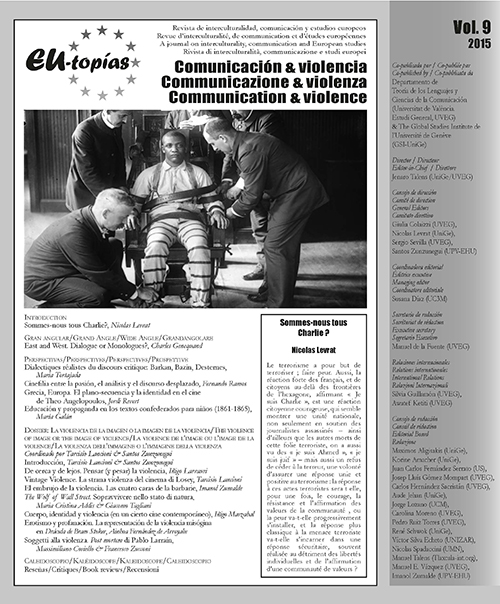Cinefilia entre la pasión, el análisis y el discurso desplazado
DOI:
https://doi.org/10.7203/eutopias.0.18745Keywords:
Cinefilia, film criticism, film theory, film history, nostalgia, Cahiers du cinéma Abstract
Abstract
Especially since the 1990s, a wide range of texts –from academic debates on postcinema/postmedia to journalistic articles mourning the ‘Decay of Cinema’– about cinephilian film culture has developed a nostalgic tone in their consideration of a past, combining historiographical reflections and autobiographical insights. The present essay analyses the main characte- ristics of cinephilian discourses since the 1950s and proposes in the first place a periodization that distinguishes between a classic phase (approx. 1945-1968) and a modern one (approx. 1968-late 1970s). Based on this distinction, this paper seeks also to analyse the way the constant revision (and reconstruction) of the cinephilian past is not just another conse- quence of the often mentioned ‘Death of the Cinema’, but an essential attribute of the cinephilian discourse since at least the 1950s as well as a further example of a (temporal) shift inherent to this discourse.
 Downloads
Downloads
 References
References
Allen, Robert C. & Gomer, Douglas (1985), Film History. Theory and Practice, New York: Knopf.
Balcerzak, Scott & Sperb, Jason (2009), Cinephilia in the Age of Digital Reproduction. Film Pleasure and Digital Culture Vol. 1, London: Wallflower Press. Allen,
Barthes, Roland (1983), Fragmentos de un discurso amoroso, México y Madrid: Siglo XXI Editores.
Baudry, Jean Louis (1975), «Le dispositif: approches métapsychologiques de l’impression de réalité», Communications, 23, pp. 56-72.
Cahiers du Cinéma (1970), «Young Mr. Lincoln de John Ford», Cahiers du Cinéma, 223, pp. 29-47.
Cheshire, Godfrey (1999), «The Death of Film/The Decay of Cinema», New York Press, 30 diciembre.
De Baecque, Antoine (2003), La Cinéphilie. Invention d’un regard, histoire d’une culture 1944-1968, Paris: Fayard. de BAeCque, Antoine & frémAux, Thierry (1995), «La cinéphilie ou l’invention d’une culture», Vingtième siècle, 46, pp. 133-142.
Douchet, Jean (2000), «Constructing the Gaze: An
Interview with Jean Douchet», Framework, 42 [http://www.frameworkonline.com/Issue42/42jd. html] (consulta: 2 septiembre 2014).
Elsaesser, Thomas (1986), «The New Film History», Sight and Sound, 55: 4, pp. 246-251.
— (2005), «Cinephilia or the Uses of Disenchantment», Marijke de Valck & Malte Hagener (ed.), Cinephilia. Movies Love and Memory, Amsterdam: Amsterdam University Press, pp. 27-43.
— (2007), «Von der Filmwissenschaft zu den Cultural Studies und zurück: der Fall Großbritannien», Zeitschrift für Kulturwissenschaften, 2, pp. 85-106.
Fernández Bianco, Víctor (1998), El cine y su público en España: un análisis económico, Madrid: Fundación Autor.
Jameson, Fredric (1991), Postmodernism or the Cultural Logic of Late Capitalism, London: Verso.
JovanoviC, Stefan (2003), «The Endings of Cinema: Notes on the Recurrent Demise of the Seventh Art. Part 1 & 2», Offscreen, 7 (4).
Keathley, Christian (2006), Cinephilia and History, or the Wind in the Trees, Bloomington: Indiana University Press.
Marie, Michel(2007), «DieFilmwissenschaftinFrankreich und der langsame Prozess ihrer Institutionalisierung», Zeitschrift für Kulturwissenschaften, 2, pp. 107-111.
Moix, Terenci(1993),ElbesodePeterPan,Barcelona: Planeta.
Mourlet, Michel (1959), «Sur un art ignoré», Cahiers du cinéma, 98 pp. 23-37.
Nieto Ferrando, Jorge (2012), Cine en papel. Cultura y crítica cinematográfica en España (1962-1982), Valencia: Ediciones de la Filmoteca.
Oliver, Jos (2002), «Ecos de la Nouvelle Vague. Influen- cias teóricas sobre la crítica española», Carlos F. Here- dero & José Enrique Monterde (ed.), En torno a la nou- velle vague. Rupturas y horizontes de la modernidad, Valencia: Institut Valencià de Cinematografia, pp. 377-390.
Pujol Ozonas, Cristina (2011), Fans cinéfilos y cinéfagos. Una aproximación a las culturas y gustos cinematográficos, Barcelona: Editorial UOC.
Rosenbaum, Jonathan & mArtin, Adrian (ed.) (2003), Movie Mutations. The Changing Face of World Cinephilia, London: BFI Publishing.
RodowiCk, D. N.(2013),«Unabrújulaparaunmundo en movimiento (sobre los géneros y las genealogías de la teoría)», EU-topías, 6, pp. 37-50.
Reynolds, Simon (2011), Retromania: Pop Culture’s Addiction to its Own Past, London: Faber and Faber.
Roud, Richard (1960), «The French Line», Sight and Sound, 29 (4), pp. 167-171.
Sontag, Susan (1996), «The Decay of Cinema», The New York Times, 25 febrero 1996, pp. 60-61.
Truffaut, François (1955), «Abel Gance, désordre et génie», Cahiers du cinéma, 47, pp. 44-46.
— (1975), «¿Qué es lo que sueñan los críticos?», Las películas de mi vida, Bilbao: Mensajero.
Tubau, Ivan (1983), Crítica cinematográfica española. Bazin contra Aristarco: La gran controversia de los años sesenta, Barcelona: Universitat de Barcelona.
Vidal Estévez, Manuel (2002), «Pensamiento y cine. Ful- gores teóricos cegueras políticas», Carlos F. Heredero & José Enrique Monterde (ed.), En torno a la nouvelle vague. Rupturas y horizontes de la modernidad, Valencia: Institut Valencià de Cinematografia, pp. 391-417.
Willemen, Paul (1994), Looks and Frictions. Essays in Cultural Studies and Film Theory, Bloomington: Indiana University Press.
Wollen, Peter(2002),«AnAlphabetofCinema»,Paris Hollywood. Writings on Film, London: Verso, pp. 1-21.
Downloads
Published
How to Cite
-
Abstract334
-
PDF (Español)128
Issue
Section
License
![]()
The authors conserve the copyright. All content published in EU-topías. Journal of interculturality, Communication, and European Studies are subject to the license Creative Commons Attribution-NonCommercial-ShareAlike 4.0 license. The full text of the license can be found at <http://creativecommons.org/licenses/by-nc-sa/4.0>
They may be copied, used, disseminated, transmitted and publicly displayed, provided that:
- The authorship and original source of the publication is cited (journal, publisher and URL of the work).
- They are not used for commercial purposes.
- The existence and specifications of this license of use are mentioned.
It is the responsibility of the authors to obtain the necessary permissions for images that are subject to copyright.



